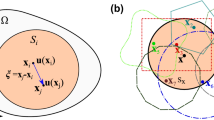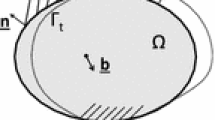Abstract
We compare the numerical performance of several methods for solving the discrete contact problem arising from the finite element discretisation of elastic systems with numerous contact points. The problem is formulated as a variational inequality and discretised using piecewise quadratic finite elements on a triangulation of the domain. At the discrete level, the variational inequality is reformulated as a classical linear complementarity system. We compare several state-of-art algorithms that have been advocated for such problems. Computational tests illustrate the use of these methods for a large collection of elastic bodies, such as a simplified bidimensional wall made of bricks or stone blocks, deformed under volume and surface forces.
Similar content being viewed by others
References
A. Berman, R. J. Plemmons: Nonnegative Matrices in the Mathematical Sciences. Computer Science and Scientific Computing Series. Academic Press, New York, 1979.
S. C. Brenner, L. R. Scott: The Mathematical Theory of Finite Element Methods. Texts in Applied Mathematics, Vol. 15. Springer-Verlag, New York, 1994.
G. Duvaut, J.-L. Lions: Inequalities in Mechanics and Physics. Grundlehren der mathematischen Wissenschaften, Vol. 219. Springer-Verlag, Berlin-Heidelberg-New York, 1976.
G. Fichera: Encyclopedia of physics. Existence Theorems in Elasticity-Boundary Value Problems of Elasticity with Unilateral Constraints, Volume VIa/2 (S. Flügge, ed.). Springer-Verlag, Berlin, 1972, pp. 347–427.
P. E. Gill, W. Murray, and M. H. Wright: Practical Optimization. Academic Press, London, 1981.
R. Glowinski, J.-L. Lions, and R. Trémolières: Numerical Analysis of Variational Inequalities. Studies in Mathematics and its Applications, Vol. 8. North-Holland, Amsterdam-New York-Oxford, 1981, English version edition.
R. L. Graves: A principal pivoting simplex algorithm for linear and quadratic programming. Oper. Res. 15 (1967), 482–494.
M. Hintermüller, K. Ito, and K. Kunisch: The primal-dual active set strategy as a semismooth Newton method. SIAM J. Optim. 13 (2003), 865–888.
M. Hintermüller, V. A. Kovtunenko, and K. Kunisch: The primal-dual active set method for a crack problem with non-penetration. IMA J. Appl. Math. 69 (2004), 1–26.
M. Hintermüller, V. A. Kovtunenko, and K. Kunisch: Generalized Newton methods for crack problems with nonpenetration condition. Numer. Methods Partial Differential Equations 21 (2005), 586–610.
I. Hlaváček, J. Haslinger, J. Nečas, and J. Lovíšek: Solution of Variational Inequalities in Mechanics. Applied Mathematical Sciences, Vol. 66. Springer-Verlag, Berlin-Heidelberg-New York, 1988.
I. Hlaváček, J. Nedoma: On a solution of a generalized semi-coercive contact problem in thermo-elasticity. Math. Comput. Simul. 60 (2002), 1–17.
N. Kikuchi, J.T. Oden: Contact Problems in Elasticity: A Study of Variational Inequalities and Finite Element Methods. Studies in Applied Mathematics, Vol. 8. SIAM, Philadelphia, 1988.
C. L. Lawson, R. J. Hanson: Solving Least Squares Problems. Series in Automatic Computation. Prentice-Hall, Englewood Cliffs, 1974.
K. G. Murty: Complementarity, Linear and Nonlinear Programming. Heldermann-Verlag, Berlin, 1988.
L.F. Portugal, J. J. Judice, and L. N. Vicente: A comparison of block pivoting and interior-point algorithms for linear least squares problems with nonnegative variables. Math. Comput. 63 (1994), 625–643.
V.V. Prasolov: Problems and Theorems in Linear Algebra. Translations of Mathematical Monographs, Vol. 134. AMS, Providence, 1994.
S. J. Wright: Primal-Dual Interior-Point Methods. SIAM, Philadelphia, 1997.
Author information
Authors and Affiliations
Additional information
This work was supported by the Engineering and Physical Science Research Council of Great Britain under grant GR/S35101, and the first author was supported by a fellowship from the Royal Society of Edinburgh.
Rights and permissions
About this article
Cite this article
Ainsworth, M., Mihai, L.A. A comparison of solvers for linear complementarity problems arising from large-scale masonry structures. Appl Math 51, 93–128 (2006). https://doi.org/10.1007/s10492-006-0008-8
Received:
Issue Date:
DOI: https://doi.org/10.1007/s10492-006-0008-8




